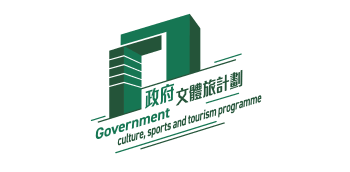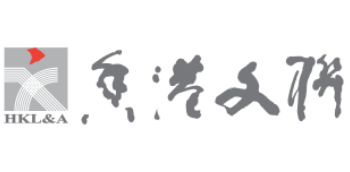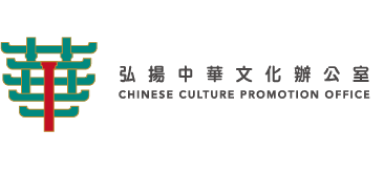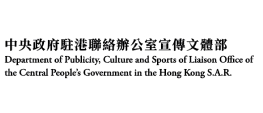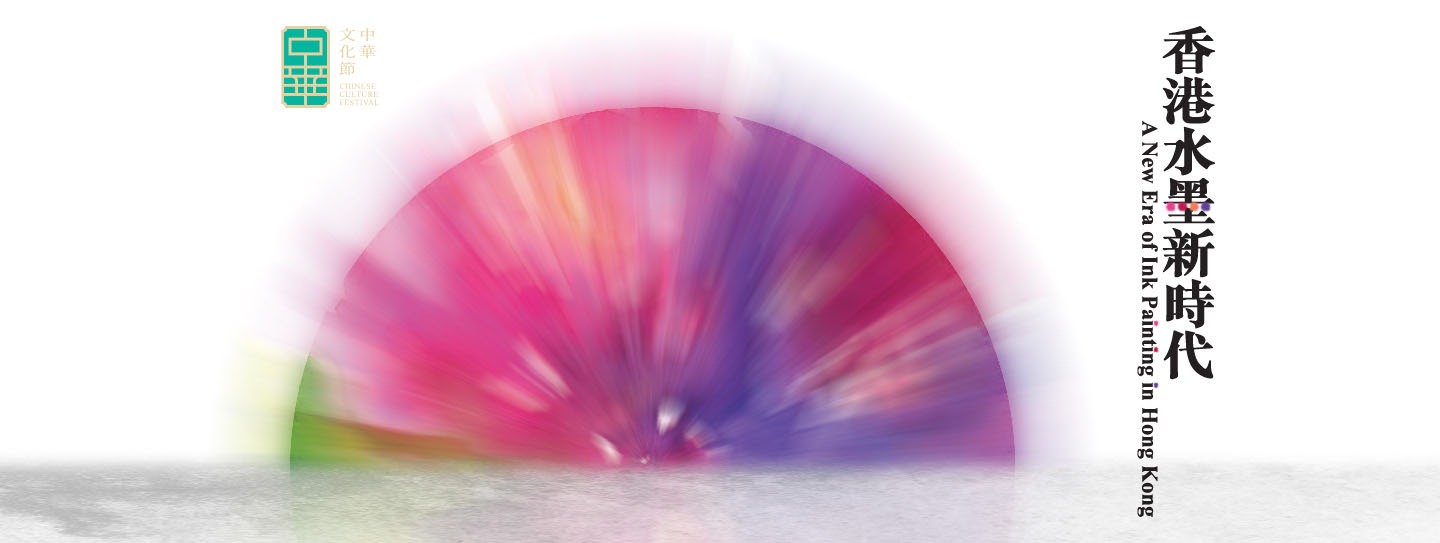
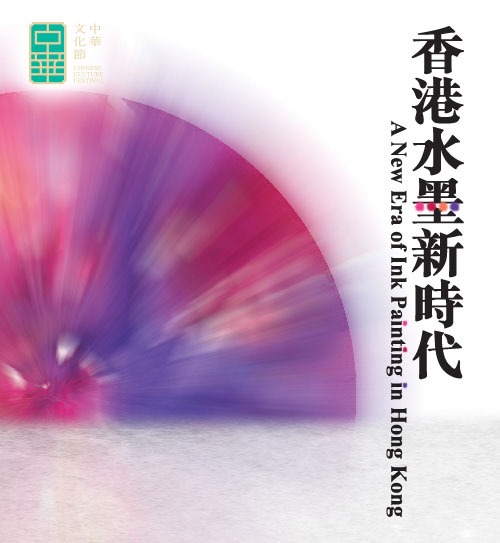
The art of ink painting was originated from the ancient Chinese civilisation for thousands of years. Hong Kong has always been under the influence of both Chinese and Western cultures and it is against this backdrop that the development of ink painting in Hong Kong has therefore been embracing the tradition whilst learning from the west. Despite the diversified and dynamic art developments in Hong Kong, Chinese ink painting remains predominantly the main stream. It provides a leading direction in aesthetics. It also shoulders the responsibility in the pursuit of the common goal of continual development of the art and cultures of both China and Hong Kong.
Exhibition Date and Time
- 18.6.2024 (二Tue) | 2:00pm-8:00pm
- 19–29.6.2024 (三Wed–六Sat) | 10:00am-8:00pm
- 30.6.2024 (日Sun) | 10:00am-4:00pm
- 18.6.2024 (二Tue)|5:00p
Extension Activities Date and Time

Content: Exploring various ways to present China, the characteristics of contemporary Hong Kong ink art, and the diverse possibilities of ink art.
23.6.2024(日Sun)| 3:00pm - 5:00pm(Putonghua and Cantonese)

Talk II:27.6.2024(四Thu) | 11:00am - 12:00pm(Putonghua)

22.6.2024(六Sat)| 11:00am - 12:pm (Cantonese)
22.6.2024(六Sat)| 3:00pm - 4:pm (Cantonese)
29.6.2024(六Sat)| 3:00pm - 4:pm (Cantonese)


20.6.2024(四Thu) | 3:00pm-3:30pm Lam Tian-xing(Cantonese or Putonghua)
21.6.2024(五Fri) | 3:00pm-3:30pm Kong Lapfung(Cantonese or Putonghua)
22.6.2024(六Sat) | 3:00pm-3:30pm Sophie Yu Chi-man(Cantonese or Putonghua)
23.6.2024(日Sun) | 3:00pm-3:30pm Chan Shing-kau(Cantonese)
24.6.2024(一Mon) | 3:00pm-3:30pm Zhao Zhijun(Putonghua)
25.6.2024 (二Tue) | 3:00pm-3:30pm Shen Ping((Cantonese or Putonghua)
26.6.2024 (三Wed) | 3:00pm-3:30pm Hung Hoi(Cantonese or Putonghua))
27.6.2024(四Thu) | 3:00pm-3:30pm Liu Suwen(Cantonese or Putonghua)
28.6.2024(五Fri) | 3:00pm-3:30pm Margaret Yeung Kwok-fan(Cantonese)
29.6.2024(六Sat) |3:00pm-3:30pm Sky Liu Sze-keung(Cantonese)
Venue
Enquiries
Art Associations: Fresh Wind of Ink Painting in Hong Kong
China is a great country with long majestic cultural history and invaluable treasures produced by uncountable art masters in her thousands of years of history. Chinese painting is always the mainstream of Chinese art, which is sustainable and continuously flourish to become a gem in the cultural history of the world. Chinese painting is also a genuine reflection of the spiritual essence and identity of the Chinese nation with significant impact and influence in world culture.
The distinctiveness of Chinese culture is its inclusiveness of blending essence of the ancient, the modern as well as all cultures of the world. In the past, the literati class of China was fond of sharing common interest and appreciation in literary gatherings to chat about poetry, painting, brewing tea, playing zither (qin) and other enjoyment to attain a transcended state of a mindful journey in heaven and earth by union with the great way of universe and mankind. Such gatherings formed the phototype of the later schools, groups or organizations.
Since the Song and Yuan Dynasties, such a trend flourished with the emergence of various painting schools like Wumen School, Huating School of the Ming Dynasty and Huangshan School, Loudong School, Yangzhou School, Shanghai School and others in the Qing Dynasty. Members either had close relationship such as teachers and students, comrades or families members, natives from the same locality or share stylistic affinity in similar styles. Such has become networks that formulate various schools of art.
These early schools or societies emerged under the literati tradition were mostly amateur groups for leisurely artistic enjoyment instead of formal structured organizations. Members not necessarily pursue the same vision, mission and value in art. However, situation drastically changed in the late 19th to the early 20th century and painting societies, art groups and movements in modern terminology appeared, bringing about a reform movement for Chinese painting. The background was that China faced internal political and economic upheavals and the invasion of foreign powers with intensive warfare, and that art was in a state of copying and following the past without innovations. Many enlightened intellectuals were aware that without renovation or even revolution, destiny of the nation would not survive any longer. A number of talents went to Europe, U.S.A. and Japan to study political and economic systems and art currents in order to revive the Chinese heritage. Under such an atmosphere, art was not only limited to personal cultivation, but need to enforce the social function of reformation and educate masses to be alerted of national consciousness, and active pursuit of common goals and visions had become dominant.
In the early 20th century, Gao Jianfu, Gao Qifeng and Chen Shuren, who had studied with the Geshan School painters Ju Lian and Ju Chao, went to Japan to pursue further studies in art, and they were active revolutionaries. These three artists pioneered a synthesis of Chinese and western art concepts and techniques to provoke an “artistic revolution” that art should serve the responsibility of social education and whatever appeal to people could become pictorial subjects. They were known as the electric school and although they never founded any formal art group, they had the same belief and their actions in publishing the provocative Truth Pictorial and founding of “Aesthetic Studio” in advocating their slogans were similar to the mission of an organized painting society. To counter such a trend, traditional painters such as Pan Dawei, Huang Boye, Deng Fen, Li Fenggong and others who advocated to revive the traditional essence of Chinese painting with new technical and pictorial interpretation of brush work and aesthetics established the “Research Society of Chinese Painting” which had its branch later formed in Hong Kong and started a debate with the Lingnan School on the future direction of Chinese painting. Historically these debates were known as the “debates between Fang (Rending) and Huang (Boye)”. In the period, young talents including Zou Wou-ki, Lin Fengmian, Xu Beihong, Guan Liang, Ding Yanyong, Fu Baoshi and others went to France, Japan and other countries to learn art. They also participated actively in exhibitions and art groups in the Mainland, paving the new path of development of Chinese painting and injected dynamic vitality to these newly founded art associations.
Hong Kong was a barren island at South without cultural and historical legacy and it only began to develop in the 19th century. From 1842, it was under British colonial rule when the Government adopted a laissez-faire cultural policy. Yet Hong Kong enjoys a favourable background with the mother country China as backbone and faces the world by absorbing nutrients from other countries in a setting with rather stable political and economic systems. Owing to the political crisis in the Mainland in the early 20th century, a number of painters moved to Hong Kong, who established private studios to earn a living or formed art groups for mutual communication and these artists include leftover calligraphers and seal-carvers such as Luo Shuzhong, Deng Erya, Ou Jiangong and others. A major society Hong Kong Art Club emerged in 1925 and branch of the Research Society of Chinese Painting was founded in 1926 by Pan Dawei, Huang Boye, Deng Erya and others to revive traditional Chinese painting. The Three Masters of the Lingnan School often toured between Guangzhou and Hong Kong, paving the foundation of the School in this city. A noted master Luis Chan returned to Hong Kong from South America in 1910, who later founded the Hong Kong Literary and Art Association (1934) and Hong Kong Artists Guild (1936), then the Chinese Contemporary Artists’ Guild in 1960, which were significant art groups in promoting western painting in Hong Kong in the early years.
Many established painters moved to Hong Kong during the transition of political power in the Mainland in 1949. The political and economic situation in the city became more consolidated from the 1950s to the 1960s, which facilitated artists to get into touch with western art currents. 12 Modernism flourished in Hong Kong and developed in parallel with traditional Chinese painting and the Lingnan School of Painting and Hong Kong art reached a new height from the 1960s to 1980s. In 1957, Lui Shou-kwan, the pioneer of New Ink Painting Movement founded the Hong Kong Artists’ Association with Kuang Yeu-ting and Douglas Bland. Then he collaborated with noted painters including Li Yanshan, Lin Jiantong, Zhao Shao’ang, Lui Long-luk and Zhang Junshi and established the Hong Kong Chinese Art Club in 1958, which was an influential organization of Chinese and western art. The same year the Hong Kong Calligraphers Association was founded and the Modern Literature and Art Association (Hong Kong) (1958–1964) emerged as a joint venture of noted masters including Wucius Wong, Van Lau, Cheung Yee, Hon Chi-fun and others. Such was instrumental in the promotion of modernism with significant impact.
Hong Kong art developed rapidly from 1960s to 1980 with emergence of more painting societies that were vital to the local art scene. The Geng Zi Calligraphy and Painting Society (1960) was founded by established artists including Ren Zhenhan, Huang Boye and Lu Wuya, which presented exhibitions to promote traditional painting. The Guangya Calligraphy Association (1967) and the Chinese Calligraphy Society (1971) were dedicated to the art of Chinese calligraphy. The Lingnan School of Painting had its root in Hong Kong with the migration of Yang Shanshen who acquainted and learnt from Gao Jianfu in 1930 and founded the Chun Feng Art Club with his followers in 1970. Zhao Shao’ang who apprenticed with Gao Qifeng already founded the Lingnan Art Studio in Guangzhou and re-established the Studio in Hong Kong in 1948 after he moved to Hong Kong whereas his student Ou Haonian, George Chao and others founded the Today’s Art Association in 1961 which remains active today. Gao Jianfu’s senior student Situ Qi and Nigel Szeto founded the Emeraldville Arts Association in the same year, and Lai Ming, a senior follower of Gao Jianfu revived the Spring Tide Painting Society in 1996. These painting organizations played an important role in promoting Lingnan painting both in this city and overseas.
Lui Shou-kwan, Master of the New Ink Painting Movement moved to Hong Kong in 1958. He pursued traditional painting, sketch and life drawing, modernism, abstract art and finally created his signature series “Zen Painting”. He had taught at the School of Extra-mural Studies of the Architecture Department, The University of Hong Kong and Hua Yan College, and nurtured a number of talented young painters who pursued individual explorations in later years, including Chui Tze-hung, Leung Kui-ting, Kan Tai-keung, Irene Chou and others. Other than founding the Hong Kong Chinese Art Club and served as a member of the Modern Literature and Art Association (Hong Kong) and various art groups, it seemed that Lui had not founded other independent art organizations. However, his students had respectively established the Circle Art Group in 1968 and One Art Group in 1971, both strived to assimilate Chinese ink aesthetics and western art styles that finally brought about the proactive New Ink Painting Movement. Students of Lui such as Leung Kui-ting and Chui Tze-hung also taught students in subsequent years and fostered budding art groups for mutual encouragements. On the other hand, the acclaimed Taiwanese painter Liu Guosong, “Father of Modern Ink Painting” came to Hong Kong in 1972 and taught at the Department of Fine Arts, The Chinese University of Hong Kong until 1990s. His rebellious theories and unique techniques had created unmatched impact on the of Chinese painting. In 1977, he founded with his students the Modern Ink Painting Society which persists to present annual exhibitions and promote contemporary painting in the Mainland, Hong Kong and Taiwan, being one of the pioneers in the modern ink art circle. His senior followers such as Chan Shing-kau, Chan Kwan-lap and others also established art groups in pursuit of ink art. The creative tides pioneered by Lui and Liu are instrumental in fostering contemporary ink art even earlier than the Mainland and Taiwan.
The merges and clashes between Chinese and western culture led to variations in terms of artistic styles and media from the 1960s to 1970s. Acquiring more opportunities to get in touch with global art currents, artists proceeded diversified pursuits, as represented by masters like Van Lau, Cheung Yee and Hon Chi-fun, founders of the In Tao Art Group, who blended Chinese archaic vocabulary such as ancient script, totemic icons, mystic imagery and eccentric beasts with western artistic modes such as sculpture, print, silk screen printing, paper casting, spray painting, acrylic as well as concepts including Pop Art, abstract art and abstract expressionism that opened a new path of development imbued with regional identity for Hong Kong. The City Museum and Art Gallery, Hong Kong was established in 1962. The Department of Fine Arts, The Chinese University of Hong Kong came into being in 1963, and both The Chinese University of Hong Kong and The University of Hong Kong offered their schools of extra-mural studies in later years to provide more exhibition opportunities and training for budding artists that would add vitality to the art community. In 1975, the Hong Kong Museum of Art organized its formal Contemporary Hong Kong Art Biennial which was an official exhibition with awards granted to recognized artists. In 1972, the International Society of Plastic & Audio-Visual Arts (Hong Kong) came into being with members like Kan Tai-keung, Chui Tze-hung, Leung Kui-ting and others and the society covered various visual forms in various media and creative possibilities. In 1974, the Visual Arts Society was established with members including Gaylord Chan, Aser Butt, Eddie Lui and others. The society explores various creative media and absorbed a number of graduates from The Chinese University of Hong Kong and other visual artists and its exhibitions and activities have extended for over 40 years. Other art groups that devoted to various artistic creations simultaneously appeared, such as the Hong Kong Graphic Association (1976), Hong Kong Sculptor’s Association (1981), the Pottery Workshop (1985), Hong Kong Modern Art Society of Watercolours (1987), etc. and these new art groups works are a testament to the diversification of Hong Kong art in the period.
From 1980s to the new Millennium, reunion with China and review of personal identity had become hot issues for Hong Kong citizens and many artists became more individualistic in their career. Art groups in different media acquired rooms for growing, such as the Jiazi Society of Calligraphy (1985), Hong Kong Lan Ting (Orchid Pavilion) Society of Art (1990), Hong Kong Calligraphy and Seal-carving Society (1991), Hong Kong Calligraphers’ Association (1992), Chinese Ink Painting Institute Hong Kong (2014), Contemporary Ceramic Society Hong Kong (1992), Hong Kong Creative Sculptors (1993), Hong Kong Sculpture Society (2007) are representative of its type. Alternative art groups also arose, including Videotage (1986) that caters for video and digital art, Hong Kong Artists’ Guild (1987) which was a pressure group on cultural infrastructures and policies. New art spaces were also new-born venues founded in this period, such as Oil Street Space, Cattle Depot, JCCAC and Tai Kwun that provided alternative working and exhibition spaces for art groups and artists. The Hong Kong ADA is a special group catering for disabilities, the International Women’s Artists (HK) Association (1993) and the Hong Kong Female Contemporary Art Association (1993) are assemblies of woman artists. The Hong Kong Society For Education In Art (1992) is an art teachers’ association focusing on art education and policy whereas the International Association of Art Critics Hong Kong (AICAHK) (1996) is an art critics organization. The flourishment of these art groups, painting societies and institutes, together with the major exhibition infrastructures such as the Hong Kong Museum of Art, M+, the Hong Kong Palace Museum and international art fairs are reflections of Hong Kong becoming a world-class cultural and art hub.
n the past decade, with artists becoming individualistic in artistic pursuits and the increase of galleries, art spaces, exhibition venues, as well as subsidy and support from the Government and private sectors, the function of art groups gradually diminishes. However, there is no lack of artists who join hands for cultivation. In 2014, The Hong Kong Artists Association was founded as one of the large-scale and representative painting society which number has now reached over 300. These painters pursue their own endeavours and conduct exchanges with their art pals to expand the contemporary vision of ink art. The China Artists Association Hong Kong Chapter was founded in 2020 with approximately 40–50 members. Majority of them are member of The Hong Kong Artists Association. To become a member of the former association, one must be a member of the China Artists Association.
The senior master Wucius Wong is acclaimed by blending design with painting and seeking inspiration from both East and West, as well as from the ancient to the modern, to pronounce his creativity with innovation and manipulation of linear configurations, compositional treatment, playing of the solid and voiding space and contrast of the black and the white. Kan Tai-keung grasps the creative spirit of new ink art, who assimilates calligraphy, painting and design to open a new artistic path. Eddie Lui is noted for modulating compositional forms, line textures, alternation of human organs and graphic planes in his works of oil painting, water-colours, print, ink painting to achieve a synthesis of Eastern and Western aesthetics. Ink works by Chu Hing-wah are imbued with passion of human relationship and social ambience. Chui Tze-hung excels in commanding a variety of media including western painting, ink painting and calligraphy with a spontaneous and bold abstract touch whereas Leung Kui-ting is prolific in transforming line textures, spatial treatment, dimensionality and ink play in his creations. Margaret Yeung Kwok Fan has been a student of the modern ink master Liu Guosong, and proceeds to new experiments in ink painting, installation and digital presentations, while Chan Shing-kau skilfully re-interprets planchette writing and calligraphic brush aesthetics and Chan Kwan-lap is noted for depicting clouds, water and tree roots with naturalistic resonance. Members of the Lingnan School of Painting are also represented in the Association. Ng Yuet-Lau carries the legacy of the Lingnan School by treating colours, light, perspective and precise brushwork in her landscape and flower paintings. He Baili excels to manipulate light and shades and texturing in enlivening his mountain and river sceneries. Lam Wu-fui is an accomplished artist in portraying cranes, fish and monkeys with the realistic essence of the Lingnan School, whereas Nigel Szeto Nai-chung puts ancient qin zither in scholar gardens to create imaginative ambience in reminiscence of the literati setting. Ma Tat-wai comes from a family of classical studies and skilfully turns ancient vessels, old trees and archaic elements with stern and vigorous brush work. These profound artists represent an assembly of talents from different sectors commanding various distinctive styles.
Majority of members come from the Mainland, including Ou Dawai who is renowned for the four literary tributes known as “calligraphy, painting, poetry and seal-carving”, Wong Chau-tung who was noted for his depictions of the prosperous and brilliant scenery of Hong Kong, Lam Mozi is noted for painting figures, calligraphy and seal-carving his manipulation of abstract, realistic and designer’s touch in the treatment of pictorial treatments. Anne(Yick Hang)’s works are imbued with fond passion for this city with distinctive representation of abstract and diluted palette. Louis Mak’s works depicting misty Mount Huang and lotuses stand out in the painting cycle with personal innovations and Shen Ping commands consummate sketch and life drawing techniques to describe scenes of Hong Kong cityscape and countryside. In his series of works portraying swimmers floating in water, Zhou Jin suggests the desolate and isolated relationship between citizens and the society in Hong Kong. Wai King-man and Chen Wei are both noted for painting of Hong Kong scenes completed with fluent and free play of ink and brush work. Hui Yanki shifted to ink painting in recent years. By skilfully manipulating empty and void spaces on the pictorial plane and dark and dry ink tones, Wong Hau-kwei captures the Victoria Harbour from photographic perspectives and his works also occasionally ironic messages. Hung Hoi has succeeded in inheriting techniques and textural modulations from past masters, and his works are also enriched with literati essence. Tien Chi transforms the contrast of the black and the white in painting, and creates fantastic reverse imageries with motifs barely hidden and appear. Liu Cheng-mui excels in oil painting with versatile themes and strong palette with a touch of dynamism. Zhao Zhijun is acclaimed for rendering of pictorial subjects with realism. Chan Keng-tin recently creates landscapes with 14 receding peaks and mountain ranges that exude tranquillity and seduction. Fan Yan is a violin player who finds her artistic language by transforming musical scores into her pictorial elements and linear delineations with rhythm.
There is a group of accomplished painters born and nurtured in Hong Kong, such as Tony Ng who is devoted to experiment new concepts and techniques in ink and brush work with swift and diluted tonal gradations for many years. Nina Pryne Sui-fun is distinguished for her rendering of landscapes with bold washes, splashes and unrestrained brush work. Winnie Mak works on print-making for years and captures Hong Kong cityscape and scenes with precise pictorial treatment and bright colours that generate a sense of brightness and dynamism. Alex Ho Siu-chung modulates endows his pictorial treatment with abstract simplicity but at the same time carry the classical resonance of Chinese ink and colour. Sky Liu Sze-keung is a senior designer and illustrator who captures Hong Kong city and street scenes with personal sensitivity that appeal to the layman. Katy Mak employs her signature themes of wave and ocean suggesting these elements would provide spiritual therapy and healing effects. These Mainland and local painters gather in this city for enrichment and new exploration in ink like hundreds of blossoms.
In recent year, the ancient gongbi (fine-line) and strong colour painting is revived to attain a high level, in particular amongst a group of young talents from the Department of Fine Art, The Chinese University of Hong Kong. They focus on mastering precise and delicate line drawings with subtle palette, as well as incorporation of contemporary subjects with ancient techniques to alternative modern vocabularies, collective memories, human relationship, thus giving gongbi painting a new face that would appeal to more audience. Graduated from the Guangzhou Fine Arts College with her study of Chinese figure painting and apprenticed with He Jiaying to get her M.F.A. degree, Sophie Yu Chi-man depicts daily life of people on the street with a touch of warmness and intimacy. Momo Lee Yee-mei, skills in handling birds and flowers by transforming gongbi style with elegant palette, whereas Yau Wing-fung, having obtained M.F.A. degree from The Chinese University of Hong Kong, recasts ancient landscapes and legends with precise outlines and subtle work. Tong Kam-ting also got her M.F.A. from The Chinese University of Hong Kong, who now engages in Chinese and art mounting profession. Her works is noted for simplicity with inherent meanings. Gessena Wong Yee-ki obtained M.F.A. from the same University and her works combines geometric and graphic forms to reconstruct ancient architectures to reshape archaic motifs. Katherine Wong Tik-wa is the daughter of Anne(Yick-hang), who devotes to contemporary ink with attempts in using calligraphic styles and segmentation of pictorial planes. Liu Jia comes from the Mainland, who untiringly pursues new styles and is skilled in depicting flowers, birds and birds with fresh charm, capturing traditional legacy, modern aesthetics in telling narratives. Lai Kwan-ting is acclaimed for painting figures with precise compositional treatment and soft lines to portray favoured themes of children and family in a passionate manner as well as suggesting the desolate state of city life. This group of young artists who chooses gongbi painting for their artistic cultivation has given new vitality to this genre of ink painting in Hong Kong.
Tang Hoi-chiu
Adjunct Professor, Academy of Visual Arts The Baptist University of Hong Kong
Former Chief Curator, Hong Kong Museum of Art
April 2024
Embracing the Traditional Spirit with Contemporary Facelift
Ink painting comprises the interactive elements of water, ink, brush and paper. I have been painting with the media of ink and water since 1958. I also used palette knives to carve my ink painting and on watercolour papers. After learning the skills of Chinese painting, I went to the United States to learn art and design. Whilst studying abroad, I also did oil paintings but have never forgotten the media of water and ink.
Decades have passed since I graduated. My art pieces are predominantly ink paintings. I have a special preference on the media of ink and water because it helps showcase the oriental nature. Undoubtedly the western art concepts, its form, style and techniques have exerted heavy influence on me. Notwithstanding being immersed between the east and the west, I still prefer using ink with brushes on water absorbent papers or clothes. My view is, contemporary Chinese paintings should have its own uniqueness. Neither should it assimilate with the western arts nor at the cost of abandoning the tradition.
I have always been focusing on literature whilst eyeing on design. I embrace the tradition when creating under contemporary ideas. As the Chinese saying goes, “The sea can hold water from thousands rivers because of its huge capacity”. I therefore believe a person is great when he can be tolerant and forgiving to others. I have always love watching from bird’s-eye views over mountains, rivers and lakes. I would then intrinsically use geometrical structures to rhythmically spin with dots and lines to demonstrate the sentimental affinities between the sky and the earth. My art pieces usually portray the extensiveness of the world where I can be included or I can become selflessness.
Wucius Wong
Museum Expert Adviser, The Leisure and Cultural Services Department of the Hong Kong SAR Government
Consultant, The Hong Kong Artists Association
April 2024
